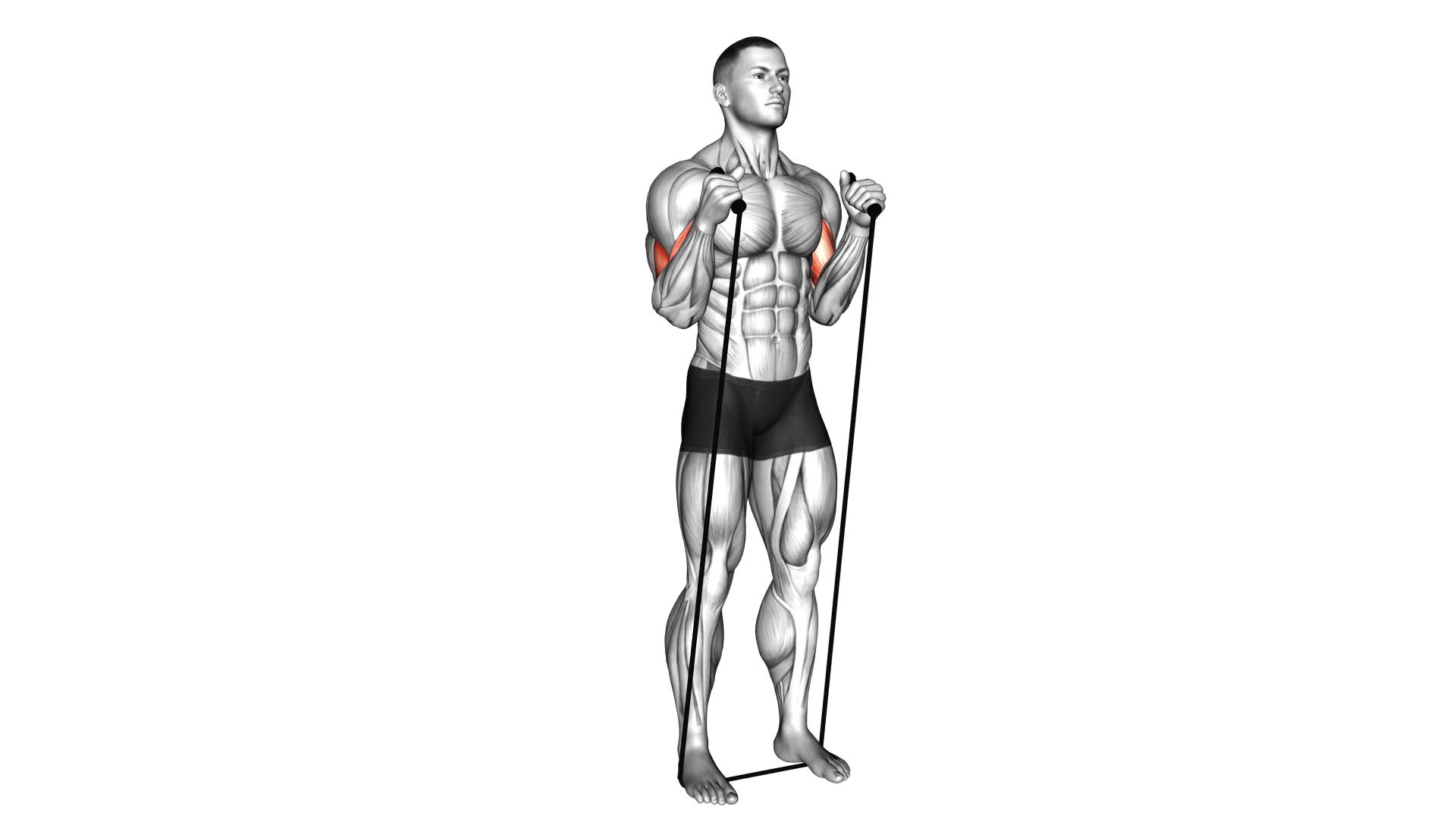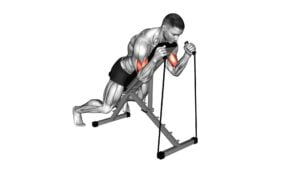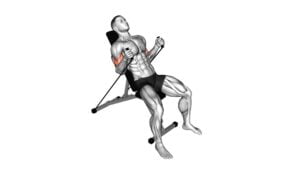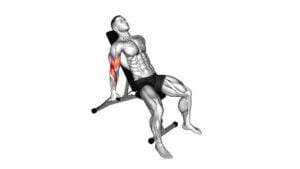Band Standing Hammer Curl – Video Exercise Guide & Tips

Are you looking for a challenging and effective arm exercise? Then you'll want to try the Band Standing Hammer Curl.
Watch This Exercise Video
This video exercise guide and tips article will show you the proper form and technique, as well as variations to spice up your workout.
With the help of this exercise, you can maximize your results and avoid common mistakes.
Get ready to strengthen and tone your arms with this powerful exercise.
Key Takeaways
- The Band Standing Hammer Curl targets the biceps and forearms while also improving grip strength.
- Proper form and technique, such as maintaining a stable stance and avoiding swinging or using momentum, are crucial for maximizing the effectiveness of the exercise.
- Variations like using resistance bands or dumbbells, incorporating supersets or tempo variations, and trying different grip or single-arm variations can spice up the workout and prevent muscle imbalances.
- To maximize results, it is important to gradually increase weight or resistance, focus on proper form and control, incorporate supersets or drop sets, allow for rest and recovery, and track progress and adjust intensity accordingly.
Benefits of the Band Standing Hammer Curl
You can experience various benefits from incorporating the band standing hammer curl into your workout routine. Bicep workouts are essential for building upper body strength and definition. The band standing hammer curl is one of the different types of bicep curls that can help you achieve these goals.
One of the main benefits of the band standing hammer curl is that it targets not only your biceps but also your forearms. By holding the dumbbells in a neutral grip, with your palms facing each other, you engage your forearms more compared to other bicep exercises. This helps in strengthening your grip and improving overall arm functionality.
Additionally, the band standing hammer curl allows for a greater range of motion compared to traditional bicep curls. This means that you can fully contract and stretch your biceps, leading to better muscle growth and development.
Furthermore, incorporating the band standing hammer curl into your workout routine can help prevent muscle imbalances in your arms. By varying your bicep exercises, you ensure that all muscles in your arms are worked evenly, reducing the risk of injuries.
To perform the band standing hammer curl, you'll need a resistance band and dumbbells of appropriate weight. Let's now explore the equipment needed for this exercise.
Equipment Needed for the Exercise
To perform the band standing hammer curl exercise, you'll require specific equipment. Here are the items you'll need:
- Resistance Bands: These are the key equipment for this exercise. Resistance bands are versatile and provide constant tension throughout the movement, helping to build strength and muscle.
- Dumbbells: While not essential, using dumbbells can add an extra challenge to the exercise and increase the resistance.
- Exercise Mat: A mat can provide cushioning and support for your knees and feet during the exercise, ensuring a comfortable and safe workout.
- Door Anchor: If you prefer to anchor your resistance bands to a door, a door anchor is necessary for stability and safety.
- Towel or Hand Grips: Using a towel or hand grips can provide a better grip on the resistance bands, preventing them from slipping during the exercise.
Resistance bands come in different types, including loop bands, tube bands, and figure-eight bands. Each type offers varying levels of resistance and can target different muscle groups. Experimenting with different types of bands can help you find the resistance level that suits your fitness level and goals.
Proper Form and Technique
To ensure proper form and technique during the band standing hammer curl exercise, focus on maintaining a stable stance and keeping your elbows close to your sides. This will help you target the biceps effectively and reduce the risk of injury.
One common mistake is swinging the body or using momentum to lift the weights. Remember to keep your upper body still and engage your biceps to perform the movement.
Another mistake is improper hand positioning. Make sure to grip the handles of the resistance bands firmly, with your palms facing each other throughout the exercise. This will ensure that your wrists are in a neutral position and prevent strain or discomfort.
Additionally, it's important to control the movement both on the way up and on the way down. Avoid rushing through the exercise and focus on squeezing your biceps at the top of the movement.
Variations to Spice Up Your Workout
To add variety to your workout, try incorporating different variations of the band standing hammer curl exercise. By changing up your routine, you can target your muscles in new ways and keep your workouts interesting. Here are some variations to spice up your workout:
- Resistance bands vs. dumbbells: Instead of using dumbbells, try using resistance bands for your hammer curls. Resistance bands provide a different type of resistance and can help improve stability and control.
- Supersets with other exercises: Incorporate supersets into your routine by pairing the band standing hammer curl with other exercises. This can help increase the intensity of your workout and save time.
- Tempo variations: Experiment with different tempos during your hammer curls. Slow down the eccentric (lowering) phase for increased muscle activation, or speed up the concentric (lifting) phase for more explosive power.
- Grip variations: Change your grip to target different muscles. Try using a neutral grip (palms facing each other) or a pronated grip (palms facing down) to engage different parts of your arms.
- Single-arm variations: Instead of using both arms simultaneously, try performing the band standing hammer curl with one arm at a time. This can help improve balance and stability.
Incorporating these variations into your band standing hammer curl exercise can help keep your workouts fresh, challenge your muscles in new ways, and bring a new level of excitement to your routine.
Tips for Maximizing Your Results
To maximize your results, incorporate these tips into your band standing hammer curl exercise routine.
First and foremost, focus on maximizing gains by increasing the weight or resistance of the bands gradually. This will challenge your muscles and stimulate growth over time.
Additionally, pay attention to your workout intensity. Push yourself to the limit by performing each rep with proper form and control. Avoid rushing through the exercise, as this can diminish the effectiveness of the movement. Instead, concentrate on the muscle contraction and squeeze at the top of each curl.
Furthermore, consider incorporating supersets or drop sets into your routine to increase the intensity even further. These techniques involve performing additional exercises or decreasing the weight after reaching muscle failure.
Lastly, don't forget about the importance of rest and recovery. Allow your muscles time to repair and grow by incorporating rest days into your training schedule.
Common Mistakes to Avoid
To ensure proper execution of the band standing hammer curl exercise, it's important to avoid common mistakes.
One common mistake is incorrect hand positioning, where the palms face inward instead of facing each other. This can reduce the effectiveness of the exercise and put unnecessary strain on the wrists.
Another mistake to avoid is lack of proper form, such as using momentum to swing the weights instead of using controlled movements.
Lastly, overloading with weight can lead to compromised form and increase the risk of injury.
Incorrect Hand Positioning
Avoid holding the band too tightly or too loosely during the Band Standing Hammer Curl exercise to ensure proper hand positioning. Proper hand positioning is crucial for maximizing the effectiveness of this exercise and preventing any potential injuries.
Here are some common mistakes to avoid when it comes to hand positioning:
- Gripping the band too tightly can cause unnecessary tension in your forearms and wrists, limiting the range of motion and reducing the effectiveness of the exercise.
- Holding the band too loosely can result in instability and a lack of control, compromising your form and increasing the risk of injury.
- Placing your hands too close together on the band can limit the activation of your biceps muscles and shift the emphasis onto your forearms.
- Holding the band too far apart can make it difficult to maintain proper form and control throughout the movement.
- Failing to maintain a neutral wrist position can put excessive stress on your wrists and lead to discomfort or injury.
Lack of Proper Form
Maintain proper form during the Band Standing Hammer Curl to maximize effectiveness and reduce the risk of injury.
One common mistake to avoid is incorrect hand positioning. Make sure to hold the dumbbells with a neutral grip, meaning your palms should face each other throughout the exercise. Avoid the temptation to rotate your wrists or let the dumbbells tilt forward or backward. Keeping your wrists straight and stable will help target the muscles in your forearms and biceps more effectively.
Another mistake to avoid is using momentum to lift the weights. Instead, focus on controlled and deliberate movements, lifting the weights up and down in a smooth and controlled manner.
Overloading With Weight
Are you wondering how to avoid overloading with weight during the Band Standing Hammer Curl? It's important to understand the concept of progressive overload and how to properly increase intensity without overdoing it. Here are some common mistakes to avoid:
- Adding too much weight too quickly can lead to injury. Gradually increase the weight to challenge your muscles without straining them.
- Neglecting proper form while focusing on heavier weights can decrease the effectiveness of the exercise and increase the risk of injury.
- Ignoring your body's signals and pushing through pain can lead to overloading the muscles and causing damage.
- Not giving your body enough time to recover between workouts can hinder progress and increase the risk of overloading.
- Forgetting to track your progress and gradually increase the weight and intensity can prevent you from achieving your fitness goals.
Frequently Asked Questions
How Many Sets and Reps Should I Do for the Band Standing Hammer Curl?
For the band standing hammer curl, you should aim for 3 sets of 10-12 reps.
This exercise targets your biceps and forearms, helping you build strength and size.
It's a great variation from regular dumbbell curls as it engages different muscle fibers.
The hammer grip also improves grip strength and forearm stability.
Incorporating this exercise into your routine can provide a well-rounded upper body workout with added benefits for your biceps and forearms.
Can I Use Dumbbells Instead of Resistance Bands for This Exercise?
Yes, you can definitely use dumbbells instead of resistance bands for the band standing hammer curl. Both options can be effective for targeting your arm muscles.
Dumbbells provide a constant resistance throughout the movement, while resistance bands offer variable resistance.
Adding the band standing hammer curl to your arm workout routine can help strengthen your biceps and forearms, improve grip strength, and enhance overall arm definition.
Incorporating this exercise can contribute to a well-rounded upper body workout.
Are There Any Modifications for People With Wrist or Elbow Pain?
If you're experiencing wrist or elbow pain, there are modifications you can make to the Band Standing Hammer Curl exercise.
One option is to use lighter weights or resistance bands with less tension.
Another alternative is to try different bicep isolation exercises that put less strain on the wrists and elbows, such as preacher curls or concentration curls.
Remember to listen to your body and consult with a fitness professional if needed.
How Often Should I Incorporate the Band Standing Hammer Curl Into My Workout Routine?
To determine the optimal frequency for incorporating the band standing hammer curl into your workout routine, consider your overall fitness goals and current training program.
It's generally recommended to perform resistance exercises like this 2-3 times per week, allowing for rest days in between.
Aim for 2-3 sets of 10-12 reps, using a weight that challenges your muscles but still allows for proper form.
Remember to listen to your body and adjust as needed.
Can I Combine the Band Standing Hammer Curl With Other Exercises for a Full Arm Workout?
Yes, you can definitely combine the band standing hammer curl with other exercises for a full arm workout. Incorporating different bicep exercises and variations of the standing hammer curl can help target different areas of your arms and provide a more comprehensive workout.
By adding in exercises like bicep curls, tricep dips, and push-ups, you can work multiple muscle groups and achieve a well-rounded arm workout.
Remember to vary your routine to keep challenging your muscles and avoid plateaus.
Conclusion
The band standing hammer curl is a highly effective exercise that targets the biceps and forearms. By using resistance bands, you can increase the intensity of the workout and build strength in these muscles.
Proper form and technique are crucial to maximize results and avoid injury. Adding variations to your routine can keep it interesting and challenging. Remember to avoid common mistakes such as using momentum or improper grip.
Follow these tips to achieve optimal results and improve your overall upper body strength.

Author
Years ago, the spark of my life’s passion ignited in my mind the moment I stepped into the local gym for the first time. The inaugural bead of perspiration, the initial endeavor, the very first surge of endorphins, and a sense of pride that washed over me post-workout marked the beginning of my deep-seated interest in strength sports, fitness, and sports nutrition. This very curiosity blossomed rapidly into a profound fascination, propelling me to earn a Master’s degree in Physical Education from the Academy of Physical Education in Krakow, followed by a Sports Manager diploma from the Jagiellonian University. My journey of growth led me to gain more specialized qualifications, such as being a certified personal trainer with a focus on sports dietetics, a lifeguard, and an instructor for wellness and corrective gymnastics. Theoretical knowledge paired seamlessly with practical experience, reinforcing my belief that the transformation of individuals under my guidance was also a reflection of my personal growth. This belief holds true even today. Each day, I strive to push the boundaries and explore new realms. These realms gently elevate me to greater heights. The unique combination of passion for my field and the continuous quest for growth fuels my drive to break new ground.







